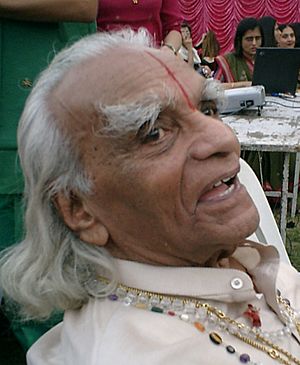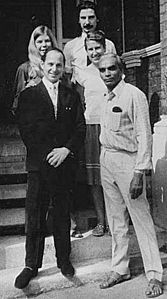B. K. S. Iyengar facts for kids
Quick facts for kids
B.K.S. Iyengar
|
|
|---|---|

Iyengar on his 86th birthday in 2004
|
|
| Born | 14 December 1918 Bellur, Kolar district, Kingdom of Mysore (now Karnataka, India)
|
| Died | 20 August 2014 (aged 95) Pune, Maharashtra, India
|
| Occupation |
|
| Known for | Iyengar Yoga |
| Spouse(s) | Ramamani |
| Children | Geeta and 5 others |
Bellur Krishnamachar Sundararaja Iyengar (born December 14, 1918 – died August 20, 2014) was an Indian yoga teacher and writer. He created a special way of practicing yoga called "Iyengar Yoga". Many people thought he was one of the most important yoga teachers in the world.
Iyengar wrote many books about yoga, including famous ones like Light on Yoga. He was one of the first students of Tirumalai Krishnamacharya, who is often called "the father of modern yoga." Iyengar helped make yoga popular, first in India and then all over the world.
The Indian government gave Iyengar important awards like the Padma Shri in 1991, the Padma Bhushan in 2002, and the Padma Vibhushan in 2014. In 2004, Time magazine named him one of the 100 most influential people in the world.
Contents
Early Life and Challenges
B.K.S. Iyengar was born into a poor family in Bellur, a village in Karnataka, India. He was the 11th of 13 children. When he was five, his family moved to Bangalore. Four years later, his father passed away.
When Iyengar was born, his hometown was affected by a big flu. This made him sick and weak for many years. As a child, he often suffered from illnesses like malaria and tuberculosis. He also didn't get enough food. He once wrote that his arms and legs were very thin, and he struggled to even lift his head.
Learning Yoga
In 1934, when Iyengar was 15, his brother-in-law, Tirumalai Krishnamacharya, invited him to Mysore. Krishnamacharya was a famous yogi. He wanted to help Iyengar get healthier by practicing yoga asanas (yoga poses).
Iyengar and other students showed their yoga skills in the Maharaja's court in Mysore. This helped Iyengar a lot. He said that even though Krishnamacharya only taught him for a short time, those days changed his life. In 1937, Krishnamacharya sent Iyengar to Pune to share the teachings of yoga. Iyengar was only 18 years old.
Even though Iyengar respected Krishnamacharya, his early training was tough. At first, Krishnamacharya didn't think the weak teenager would be good at yoga. Iyengar was often given household chores instead of yoga lessons. Serious training began only when another student left. Krishnamacharya taught him difficult poses and sometimes told him not to eat until he mastered a pose. These experiences later shaped how Iyengar taught his own students.
Even when he was 90 years old, Iyengar continued to practice yoga poses for three hours every day. He also practiced breathing exercises for an hour.
Becoming World Famous
In 1952, Iyengar met a famous violinist named Yehudi Menuhin. This meeting helped Iyengar become known around the world. Menuhin was interested in yoga. When they met, Menuhin was very tired. Iyengar told him to lie down in a relaxing pose called Savasana. Menuhin fell asleep and woke up an hour later feeling refreshed.
Menuhin believed that yoga helped him play the violin better. In 1954, he invited Iyengar to Switzerland. Menuhin even gave Iyengar a watch with a special message: "To my best violin teacher, BKS Iyengar." After this, Iyengar visited Western countries often. In Switzerland, he also taught Vanda Scaravelli, who later created her own yoga style.
Iyengar taught yoga to many famous people. These included the philosopher Jiddu Krishnamurti and the Queen of Belgium, Elisabeth, whom he taught a headstand when she was 80 years old! Other well-known students included the writer Aldous Huxley, actress Annette Bening, and Indian cricket star Sachin Tendulkar.
Iyengar first visited the United States in 1956. He taught classes and gave demonstrations in Ann Arbor, Michigan. He returned to Ann Arbor several times in the 1970s.
In 1966, Iyengar published his first book, Light on Yoga. It became a huge success worldwide. By 2005, it had been translated into 17 languages and sold three million copies. He wrote 13 more books about yoga poses and philosophy.
-
In 1954, the violinist Yehudi Menuhin invited Iyengar to teach in Europe.
In 1975, Iyengar opened the Ramamani Iyengar Memorial Yoga Institute in Pune, India. He named it after his wife, who had passed away. He officially stopped teaching in 1984, but he continued to be active in the world of Iyengar Yoga. He taught special classes, gave talks, and wrote books. His daughter, Geeta, and son, Prashant, also became famous yoga teachers.
Iyengar helped his students by teaching them how to become stronger and more flexible. After a scooter accident injured his spine, he started using props like blocks and straps. These props helped people with injuries or disabilities practice yoga. He was known for being strict but also caring with his students.
Helping Others
Iyengar cared a lot about nature. He believed it was important to protect all animals and birds. He gave a large donation to the Chamarajendra Zoological Gardens in Mysore, India. He even adopted a tiger and a cub in memory of his wife.
He also helped raise awareness about multiple sclerosis, a health condition, with a group in Pune.
One of Iyengar's most important projects was helping his ancestral village of Bellur. He set up a fund called the Bellur Trust. Through this fund, he helped transform the village. He built a hospital, a special temple dedicated to Patanjali (a famous yoga sage), and a free school. The school provides uniforms, books, and hot lunches to children from Bellur and nearby villages. He also built a secondary school and a college.
His Family
In 1943, Iyengar married Ramamani. She was 16 years old, and their marriage was arranged by their parents, which was common in India. He said they lived "as if our two souls were one." They had five daughters and one son. Ramamani passed away in 1973. Iyengar named his yoga institute in Pune after her.
Both Iyengar's oldest daughter, Geeta (1944–2018), and his son, Prashant, became well-known yoga teachers. Geeta wrote a book called Yoga: A Gem for Women. Prashant has also written several books about yoga. After Geeta's death, Prashant became the director of the Ramamani Iyengar Memorial Yoga Institute (RIMYI) in Pune. Iyengar's granddaughter, Abhijata Sridhar Iyengar, also trained with him and now teaches yoga around the world.
Iyengar passed away on August 20, 2014, in Pune, when he was 95 years old.
His Lasting Impact
On October 3, 2005, the city of San Francisco declared it "B.K.S. Iyengar Day." A professor named Joseph S. Alter said that Iyengar had the biggest impact on spreading yoga around the world. In June 2011, China Post (China's postal service) even released a special stamp in his honor. At that time, there were over 30,000 Iyengar yoga students in 57 cities in China.
The word "Iyengar" is now in the dictionary! Oxford Dictionaries defines "Iyengar" (short for "Iyengar Yoga") as a type of yoga that focuses on getting the body in the correct position. It often uses straps, blocks, and other tools to help with poses.
On December 14, 2015, which would have been Iyengar's 97th birthday, Google Doodle honored him with a special drawing on their homepage. Several documentary films have also been made about his life and work, including Yogacharya B.K.S. Iyengar: Uniting Through Yoga (2018) and Leap of Faith (2008).
Today, thousands of yoga teachers are Certified Iyengar Yoga Teachers (CIYTs). Over 1,100 of them are in the United States alone.
Awards and recognition
- 1991: Awarded the Padma Shri.
- 2002: Received the Padma Bhushan.
- 2014: Awarded the Padma Vibhushan.
Images for kids
See also
 In Spanish: B. K. S. Iyengar para niños
In Spanish: B. K. S. Iyengar para niños




